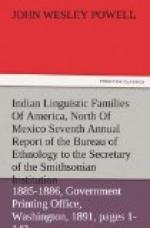The author has delayed the present publication somewhat, expecting to supplement it with another paper on the characteristics of those languages which have been most fully recorded, but such supplementary paper has already grown too large for this place and is yet unfinished, while the necessity for speedy publication of the present results seems to be imperative. The needs of the Bureau of Ethnology, in directing the work of the linguists employed in it, and especially in securing and organizing the labor of a large body of collaborators throughout the country, call for this publication at the present time.
In arranging the scheme of linguistic families the author has proceeded very conservatively. Again and again languages have been thrown together as constituting one family and afterwards have been separated, while other languages at first deemed unrelated have ultimately been combined in one stock. Notwithstanding all this care, there remain a number of doubtful cases. For example, Buschmann has thrown the Shoshonean and Nahuatlan families into one. Now the Shoshonean languages are those best known to the author, and with some of them he has a tolerable speaking acquaintance. The evidence brought forward by Buschmann and others seems to be doubtful. A part is derived from jargon words, another part from adventitious similarities, while some facts seem to give warrant to the conclusion that they should be considered as one stock, but the author prefers, under the present state of knowledge, to hold them apart and await further evidence, being inclined to the opinion that the peoples speaking these languages have borrowed some part of their vocabularies from one another.
After considering the subject with such materials as are on hand, this general conclusion has been reached: That borrowed materials exist in all the languages; and that some of these borrowed materials can be traced to original sources, while the larger part of such acquisitions can not be thus relegated to known families. In fact, it is believed that the existing languages, great in number though they are, give evidence of a more primitive condition, when a far greater number were spoken. When there are two or more languages of the same stock, it appears that this differentiation into diverse tongues is due mainly to the absorption of other material, and that thus the multiplication of dialects and languages of the same group furnishes evidence that at some prior time there existed other languages which are now lost except as they are partially preserved in the divergent elements of the group. The conclusion which has been reached, therefore, does not accord with the hypothesis upon which the investigation began, namely, that common elements would be discovered in all these languages, for the longer the study has proceeded the more clear it has been made to appear that the grand process of linguistic development among the tribes of North America has




